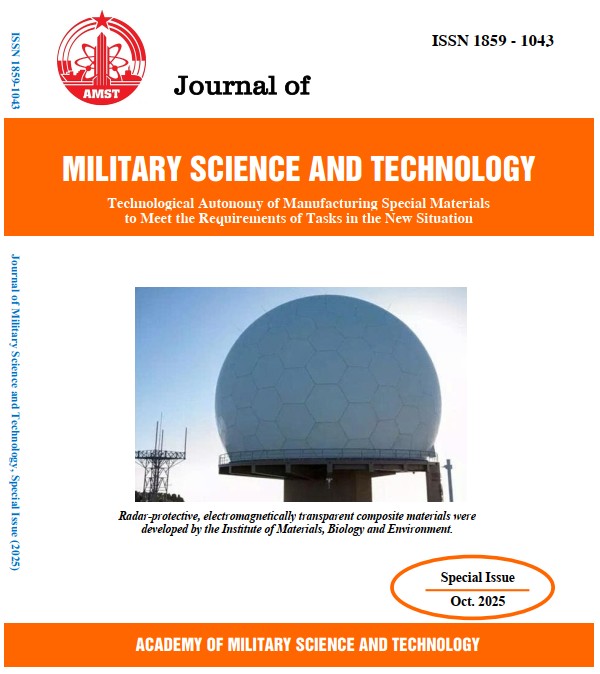Freeze drying WO₃ nanostructures for photocatalyst degradation of Rhodamine B dye from aqueous solution
118 viewsDOI:
https://doi.org/10.54939/1859-1043.j.mst.IMBE.2025.95-101Keywords:
Tungsten trioxide (WO₃); Photocatalysis; Rhodamine B degradation; Hydrothermal synthesis; Advanced oxidation process; Wastewater treatment.Abstract
This study reports the synthesis and evaluation of tungsten oxide (WO₃) nanostructures prepared by a controlled hydrothermal method combined with freeze-drying for efficient Rhodamine B (RhB) degradation. The materials were characterized using XRD, SEM, and UV-Vis DRS, confirming a hexagonal crystal structure and strong visible-light absorption. Photocatalytic performance was examined under simulated sunlight, showing rapid RhB degradation with over 90% removal achieved within 120 minutes. Kinetic analysis indicated pseudo-first-order behavior, consistent with typical photocatalytic processes. The catalyst also exhibited excellent reusability and stability, maintaining more than 90% efficiency after three cycles and over 80% after seven cycles. These results demonstrate that freeze-drying effectively preserves porous nanostructures and enhances photocatalytic performance. Overall, the synthesized WO₃ nanostructures represent a cost-effective, durable, and sustainable photocatalyst with significant potential for wastewater treatment, contributing to the advancement of visible-light-driven advanced oxidation processes for environmental remediation.
References
[1]. Sharma, J., Sharma, S., and Soni, V. “Classification and impact of synthetic textile dyes on aquatic flora: A review.” Regional Studies in Marine Science, vol. 45, p. 101802, (2021). DOI: https://doi.org/10.1016/j.rsma.2021.101802
[2]. Guan, Y., Wu, W., Su, J., and Zhang, L. “Synthesis of rhodamine B amine derivatives with improved light resistance and its application in thermochromic materials.” Dyes and Pigments, vol. 233, p. 112529, (2025). DOI: https://doi.org/10.1016/j.dyepig.2024.112529
[3]. Ismail, M., et al. “Pollution, toxicity and carcinogenicity of organic dyes and their catalytic bio-remediation.” Current Pharmaceutical Design, vol. 25, no. 34, pp. 3645–3663, (2019). DOI: https://doi.org/10.2174/1381612825666191021142026
[4]. Al-Tohamy, R., et al. “A critical review on the treatment of dye-containing wastewater: Ecotoxicological and health concerns of textile dyes and possible remediation approaches for environmental safety.” Ecotoxicology and Environmental Safety, vol. 231, p. 113160, (2022). DOI: https://doi.org/10.1016/j.ecoenv.2021.113160
[5]. Iqbal, M. A., et al. “Advanced photocatalysis as a viable and sustainable wastewater treatment process: A comprehensive review.” Environmental Research, vol. 253, p. 118947, (2024). DOI: https://doi.org/10.1016/j.envres.2024.118947
[6]. Suhaimi, N. H. S., et al. “Recent updates on TiO₂-based materials for various photocatalytic applications in environmental remediation and energy production.” Desalination and Water Treatment, vol. 321, p. 100976, (2025). DOI: https://doi.org/10.1016/j.dwt.2024.100976
[7]. Huang, J., Yue, P., Wang, L., She, H., and Wang, Q. “A review on tungsten-trioxide-based photoanodes for water oxidation.” Chinese Journal of Catalysis, vol. 40, no. 10, pp. 1408–1420, (2019). DOI: https://doi.org/10.1016/S1872-2067(19)63399-1
[8]. Raub, A. A. M., Bahru, R., Nashruddin, S. N. A. M., and Yunas, J. “Advances of nanostructured metal oxide as photoanode in PEC water splitting application.” Heliyon, vol. 10, no. 20, (2024). DOI: https://doi.org/10.1016/j.heliyon.2024.e39079
[9]. Nguyen, H. S., et al. “Ag-decorated novel h’-WO₃ nanostructures for sustainable applications.” Journal of Materials Science, vol. 48, no. 13, pp. 18687–18698, (2022). DOI: https://doi.org/10.1016/j.ceramint.2022.03.142
[10]. Pham, N. L. et al., “Temperature-mediated phase transformation and optical properties of tungsten oxide nanostructures prepared by hydrothermal method.” Materials Chemistry and Physics, vol. 32, no. 3, pp. 307–307, (2022). DOI: https://doi.org/10.15625/0868-3166/16754
[11]. Tahir, M. B., et al. “WO₃ nanostructures-based photocatalyst approach towards degradation of RhB dye.” Journal of Materials Science: Materials in Electronics, vol. 28, no. 3, pp. 1107–1113, (2018). DOI: https://doi.org/10.1007/s10904-017-0771-x
[12]. Zhang, Y., et al. “Novel synthesis method of oxygen vacancy WO₃ and its photocatalytic performance for degradation of rhodamine B.” Ceramics International, vol. 98, no. 6, pp. 1542–1550, (2023). DOI: https://doi.org/10.1002/jctb.7379
[13]. Zhang, G., et al. “Effects of annealing temperature on optical band gap of sol–gel tungsten trioxide films.” Journal of Sol-Gel Science and Technology, vol. 9, no. 8, p. 377, (2018). DOI: https://doi.org/10.3390/mi9080377
[14]. Gorobtsov, P. Y., et al. “Synthesis of nanoscale WO₃ by chemical precipitation using oxalic acid.” Russian Journal of Inorganic Chemistry, vol. 66, no. 12, pp. 1811–1816, (2021). DOI: https://doi.org/10.1134/S0036023621120032
[15]. Nakrela, A., et al. “Comprehensive investigation of WO₃-x thin films: Structural, optical, and electrical insights, with application in photodegradation of dyes.” Journal of Materials Research and Technology, (2025). DOI: https://doi.org/10.1016/j.ceramint.2025.02.009
[16]. Jamali, M., Tehrani, F. S., and B. E. “Thermally stable WO₃ nanostructure synthesized by hydrothermal method without using surfactant.” Materials Science, vol. 270, p. 115221, (2021). DOI: https://doi.org/10.1016/j.mseb.2021.115221
[17]. Ma, Y., et al. “Synthesis of superhydrophobic crack‐free monolithic silica aerogels via a vacuum freeze‐drying process.” Journal of the American Ceramic Society, vol. 108, no. 6, p. e20401, (2025). DOI: https://doi.org/10.1111/jace.20401
[18]. Trenkenschuh, E. “Freeze-drying of nanoparticles: Impact of particle properties on formulation and process development.” LMU Dissertation, (2021).
[19]. L. T. L., et al. “Synthesized and characterization of WO₃ nanorod hybridization Gr application in environmental treatment.” Results in Engineering, vol. 90, (2021).
[20]. Zhu, Q., et al. “Efficient photocatalytic removal of RhB, MO and MB dyes by optimized Ni/NiO/TiO₂ composite thin films under solar light irradiation.” Materials Today: Proceedings, vol. 6, no. 2, pp. 2724–2732, (2018). DOI: https://doi.org/10.1016/j.jece.2018.04.017
[21]. Nguyen, K. D., et al. “Facile one-step synthesis of in situ WO₃@Gr nanorods as an efficient material for antimicrobial and decoloration applications.” Nanotechnology, vol. 15, no. 2, p. 025009, (2024). DOI: https://doi.org/10.1088/2043-6262/ad4851
[22]. Pham, N. L., Luu, T. L. A., Nguyen, H. L., Nguyen, C. T. “Effects of acidity on the formation and adsorption activity of tungsten oxide nanostructures prepared via the acid precipitation method.” Materials Chemistry and Physics, vol. 272, p. 125014, (2021). DOI: https://doi.org/10.1016/j.matchemphys.2021.125014
[23]. Duan, G., et al. “Robust antibacterial activity of tungsten oxide (WO₃-x) nanodots.” Colloids and Surfaces B: Biointerfaces, vol. 32, no. 7, pp. 1357–1366, (2019). DOI: https://doi.org/10.1021/acs.chemrestox.8b00399
[24]. Luu, T. L. A., et al. “Graphene oxide-wrapped tungsten trioxide for adsorptive removal of methylene blue.” Materials Chemistry and Physics, vol. 316, p. 129033, (2024). DOI: https://doi.org/10.1016/j.matchemphys.2024.129033







